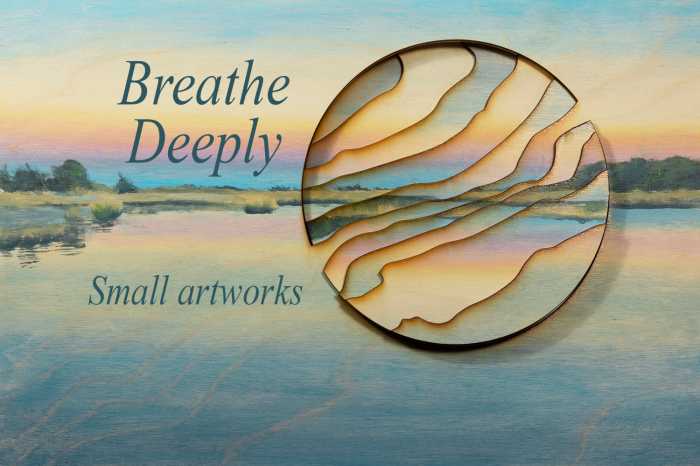Montauk's Ditch Plains Celebrated in New Photo Book

When Nat Ward first discovered Ditch Plains in 2018, it was already well established among locals and tourists as one of the most famous and beloved beaches in the Hamptons. But for Ward, what unfolded before him that day was a revelation that led to years of photography and, in the end, a brilliant new book, Ditch: Montauk New York, 11954.
Featuring about 50 images shot on medium-format 6×17 film cameras, the photographs in Ditch are all panoramic and printed by hand in a darkroom, making each one a unique art object with a level of authenticity that’s perhaps lost in the infinite digital prints most create today.
Ward bought the first medium-format camera on eBay one night on a whim, and happened to have it with him on the day he emerged from a trail atop the Montauk bluffs to find The End’s most popular, and populated, beach.
“I drove over to Shadmoor State Park, because I love that hike past the old bunkers. And I thought maybe I’ll photograph here,” Ward says, recalling the day he found the beach that would consume his next four summers. After deciding he would not shoot landscapes and instead try something unexpected with the format, he saw a pair of women posing for a selfie on the cliff and he snapped a photo of them. It didn’t end up in the book, but Ward acknowledges that it was the shot that “set the stage” for his Ditch project and “thinking about this beautifully and absurdly silly thing that is the social landscape of the beach, and all the pleasure that goes along with it.”

He saw a pair of flip-flops a little farther along the path, alerting him to the fact that people were likely swimming below, leading him to find Ditch Plains, a beach with the most consistent surf break on the East End, and a low-key hideaway for the rich and famous as well as the most local of locals, all gathered on a sandy alcove surrounded by dunes, scrub and nearby cliffs. It quickly became his mission to document this paradise and the people inhabiting it.
“Because of the political and social realities of 2018 … I was really despondent and very sad about the state of things, and then I found this place where I walked up and down the beach that first time and people were calling out to me. People were willing to have a conversation for 45 minutes. They were excited about being photographed. They were experiencing pleasure in public together,” Ward says, explaining that his attraction to Ditch Plains transcended its magnificent setting. “It’s all kinds of people crushed together on that beach, and I just thought, wow, they don’t know it, but this is actually like a very rebellious thing to do in a moment where the entire news media is talking about factionalism and conflict, and how you can’t go to Thanksgiving, right? So it was refreshing, and it was something that I really needed.”
Ward, now 41, also notes his daughter was just over a year old, and he was looking for a vision of the world that wasn’t so bleak, like he’d just chronicled in his book Big Throat, which explored themes of death and the overwhelming weight and power of the high desert in the shadow of New Mexico’s Rio Grande Gorge Bridge.
The pictures in Ditch capture people of all body types and ages, from beautiful young nymphs in bikinis to the overweight, elderly and absolutely sun baked, but Ward’s vision never feels cynical. His lens never passes judgement, and those who appear in his photographs don’t look self-conscious or ashamed. And it’s by design.

For example, in a world where cellphones are as ubiquitous as beach towels, we see almost none in this book. The artist is not looking for the easy commentary so many might grab, depicting jaded youth scrolling TikToks instead of enjoying the joyful living and natural splendor around them. He chooses to capture something different.
“We’re kind of dealing with what Sontag said, which is a picture is an invitation into a fantasy, and if I’m being invited into a fantasy, do I want to sit across the table from someone just scrolling on their phone and going, ‘Uh huh, yeah, uh huh’ — no! It shows that they don’t care about me. And I genuinely feel when I see pictures of people with cellphones that the character in that photograph, the only thing they could possibly be broadcasting is that they don’t care about the world around them, and by extension, the viewer, me, right?”
So, while it might lean toward the ideal, Ditch: Montauk New York, 11954 also feels very much like an honest picture of this place and time, because it’s not a cynical or lonely spot. As Montauk resident and musician Rufus Wainwright and his husband, arts administrator Jorn Weisbrodt, write in one of three essays featured in the book, “We love the beach just as much as we love our homes. Simply put, the beach is home to us.”
And Ward has done a fine job communicating exactly that.
Learn more about Nat Ward at nat-ward.com.









